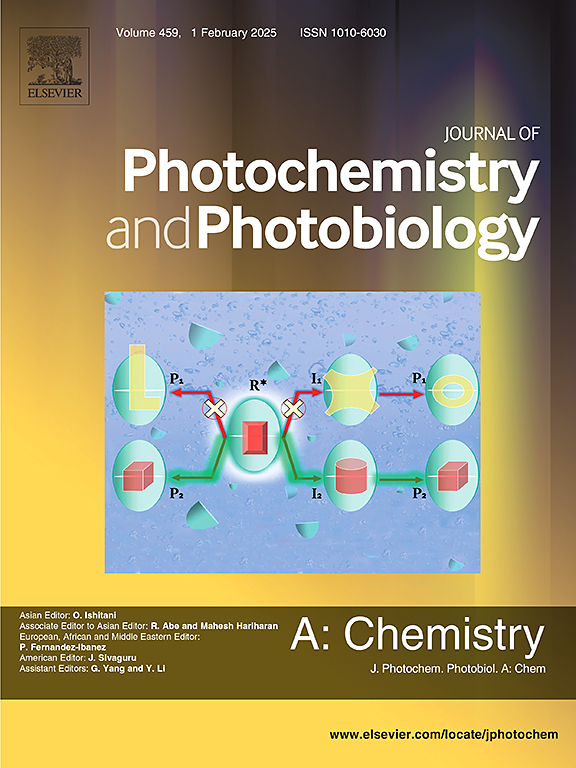碱土共掺杂MgGa2O4:Cr3+近红外荧光粉可调Cr3+-Cr3+离子对发光特性
IF 4.1
3区 化学
Q2 CHEMISTRY, PHYSICAL
Journal of Photochemistry and Photobiology A-chemistry
Pub Date : 2025-07-09
DOI:10.1016/j.jphotochem.2025.116612
引用次数: 0
摘要
Cr3+-Cr3+离子对作为一种高效的近红外(NIR)发光中心,与分离的Cr3+离子相比,具有更好的热稳定性和更宽的短波红外(SWIR)带宽。然而,它的形成通常需要较高的Cr3+浓度,这可能导致浓度猝灭。在此,我们提出了一种原子取代策略来调节Cr3+-Cr3+对的形成,而不依赖于过量的Cr3+掺杂。以MgGa₂O₄:Cr3+为模型体系,通过密度泛函理论(DFT)计算结合实验分析发现,碱土金属取代四面体Mg位会影响Cr3+-Cr3+离子对的形成。Mg位点上较大的离子半径有利于形成Cr3+-Cr3+离子对。通过引入Be, Ca, Sr或Ba,我们成功地控制了Cr3+-Cr3+对中心的居群,将SWIR发射强度调节在800 ~ 1200 nm之间。这项工作加深了对Cr3+-Cr3+离子中心形成的理解,并为定制SWIR发光提供了新的途径。本文章由计算机程序翻译,如有差异,请以英文原文为准。
Tunable Cr3+-Cr3+ ion pair luminescence properties of MgGa2O4:Cr3+ NIR phosphors via alkaline-earth metal co-doping
The Cr3+-Cr3+ ion pair has emerged as a highly efficient near-infrared (NIR) luminescence center with improved thermal stability and broader short-wave-infrared (SWIR) bandwidth compared to isolated Cr3+ ions. However, its formation typically requires high Cr3+ concentrations, which may induce concentration quenching. Herein, we propose an atomic substitution strategy to regulate Cr3+-Cr3+ pair formation without relying on excessive Cr3+ doping. Using MgGa₂O₄: Cr3+ as a model system, density functional theory (DFT) calculations combined with experimental analysis reveal that substituting tetrahedral Mg sites with alkaline earth metals influences Cr3+-Cr3+ ion pair formation. A larger ionic radius at the Mg site facilitates easier formation of Cr3+-Cr3+ ion pairs. By introducing Be, Ca, Sr, or Ba, we successfully controlled the population of Cr3+-Cr3+ pair centers, tuning SWIR emission intensity between 800 and 1200 nm. This work deepens understanding of Cr3+-Cr3+ ion center formation and offers a new route to tailor SWIR luminescence.
求助全文
通过发布文献求助,成功后即可免费获取论文全文。
去求助
来源期刊
CiteScore
7.90
自引率
7.00%
发文量
580
审稿时长
48 days
期刊介绍:
JPPA publishes the results of fundamental studies on all aspects of chemical phenomena induced by interactions between light and molecules/matter of all kinds.
All systems capable of being described at the molecular or integrated multimolecular level are appropriate for the journal. This includes all molecular chemical species as well as biomolecular, supramolecular, polymer and other macromolecular systems, as well as solid state photochemistry. In addition, the journal publishes studies of semiconductor and other photoactive organic and inorganic materials, photocatalysis (organic, inorganic, supramolecular and superconductor).
The scope includes condensed and gas phase photochemistry, as well as synchrotron radiation chemistry. A broad range of processes and techniques in photochemistry are covered such as light induced energy, electron and proton transfer; nonlinear photochemical behavior; mechanistic investigation of photochemical reactions and identification of the products of photochemical reactions; quantum yield determinations and measurements of rate constants for primary and secondary photochemical processes; steady-state and time-resolved emission, ultrafast spectroscopic methods, single molecule spectroscopy, time resolved X-ray diffraction, luminescence microscopy, and scattering spectroscopy applied to photochemistry. Papers in emerging and applied areas such as luminescent sensors, electroluminescence, solar energy conversion, atmospheric photochemistry, environmental remediation, and related photocatalytic chemistry are also welcome.

 求助内容:
求助内容: 应助结果提醒方式:
应助结果提醒方式:


